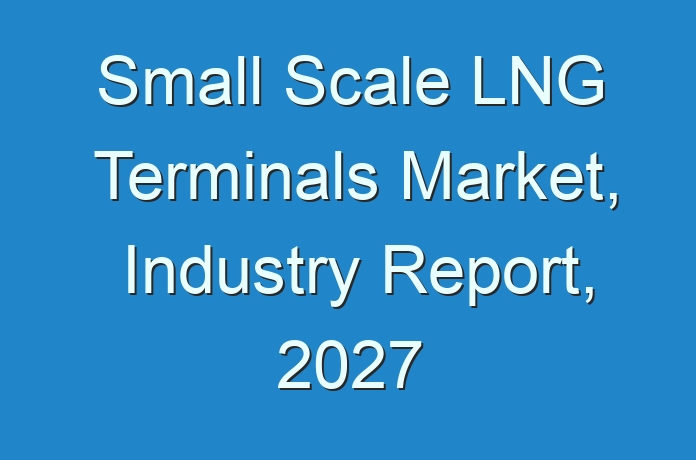
Key Highlights
- The global small scale LNG terminals market was around 70.90 MMTPA in 2018 and is anticipated to rise at a CAGR of more than 10.4% during the forecast period
- The regasification segment accounted for major share of the small scale LNG terminals market in 2018, due to the increasing demand and consumption of natural gas in automotive and industrial sector
- The onshore segment held prominent share of the small scale LNG terminals market in 2018. High demand of onshore facilities for supply of LNG to the urban transportation network as well as to LNG bunkering facilities.
- Asia Pacific is expected to grow at a significant pace in the near future, due to the rising demand for natural gas in the region as a cleaner alternative to coal and refined products for power generation and as a fuel, especially in developing countries such as China and India
Download PDF Brochure – https://www.transparencymarketresearch.com/sample/sample.php?flag=B&rep_id=4687
Small Scale LNG Terminals Market Driven by Rising Demand for LNG
The small scale LNG terminals market faces promising prospect ahead as US Energy Department reported a near 100% rise in LNG exports during 2018-19 period. In 2018, the total domestically manufactured LNG in the US, one of the world’s biggest exporter, stood at 1,972.3 Billion cubic feet (bcf). The figure rose to an incredible 3,379.9 bcf of natural gas at the end of 2019. Additionally, the demand for the products has risen considerably in new regions including those of Latin America, wherein 933.8 bcf were exported which made the region extremely prominent in the market with a share of 27.6% in Oct 2019.
The growing demand for LNG products, and promising opportunities in small LNG terminals will drive tremendous growth for the market. Growing demand for bunker fuels will drive robust growth for the small scale LNG terminals market in the near future. The growing demand for sustainability, and recent changes in European naval regulations will drive growth for the liquid variety of natural gas in the near future.
More Trending Reports by Transparency Market Research – https://www.prnewswire.com/news-releases/oil–gas-epc-market-to-reach-a-valuation-of-us-64-7-bn-by-2027-growth-in-ep-in-oil-and-gas-industry-boosting-growth-states-transparency-market-research-301005816.html
Despite Barriers to Growth, LNG to Reach 10% Global Crude Production
The sulphur-emission from global shipping has emerged as a major threat for climate conditions. It is estimated that the industry results in 18% harmful emissions of air-pollutants globally. This has brought new changes in the industry, which will go into effect starting from January 1, 2024. The new regulations allow for 0.5% emission of sulphur from previous 3.5%. The major reduction in proposed emissions will require the industry to use much cleaner sources of fuel, including LNG. The liquid variety of natural gas has remained restricted in growth previously as its production costs and the need for storage remained barriers to its growth. However, new regulations and growing exports of countries like the US ensure that the energy from LNG will form 10% of crude production by 2024. It is likely to increase thereafter as new players in production like the United States, promise lower prices due to advance manufacturing techniques, and considerably supply of the clean energy.
Request For the Customization – https://www.transparencymarketresearch.com/sample/sample.php?flag=CR&rep_id=4687
Asia Pacific Remains Key Region for Exports as Shipping, Automotive, and Power Industry Drives Growth
LNG can promise a higher reduction in volume as compared to compressed natural gas. This makes it easier for the gas to be used instead of alternatives like CNG or diesel fuel for marine transport over long distances. The governments in the region are also promoting natural gas as a transportation fuel and are investing heavily in natural gas infrastructure to reduce their carbon footprint. Moreover, power plants in the region are now shifting towards natural gas from coal and other petroleum products for power generation in order to minimize their environmental footprint. Thus, growing shipping, automotive, and power industry in Asia pacific, will drive most growth for the small scale LNG terminals market in the near future. Among regions, the US exported 1,253.0 bcf to Asia Pacific, wherein demand for metals is driving a major surge in shipping in countries like Korea, Japan, and China.
Request for covid19 Impact Analysis – https://www.transparencymarketresearch.com/sample/sample.php?flag=covid19&rep_id=4687
Global Small Scale LNG Terminals Market – Key Developments
- In November 2018, Avenir LNG Limited announced that the company would be collaborating with Golar Power Limited in order to develop small-scale LNG market in Brazil. The company’s second LNG Carrier of 7,500 cubic meter capacity would be delivering LNG to various ports across Brazil. The vessel would also possess ship-to-ship bunkering capability, which is an aspect of company’s global multi-nodal bunkering solution.
- In April 2019, Bengal Concession Private Limited (BCPL) a subsidiary of H-Energy announced its plan to commission its upcoming LNG Re-gasification (RLNG) terminal in West Bengal, India by May 2024. The upcoming LNG terminal is expected to have regasification capacity of around 1.5-3 MMTPA, which would be further expanded up to 5 MMTPA in the future. BCPL also intends to develop a small scale LNG regasification and storage terminal on the banks of Hooghly River in Matriramchak village, East Medinipur, West Bengal, India.





